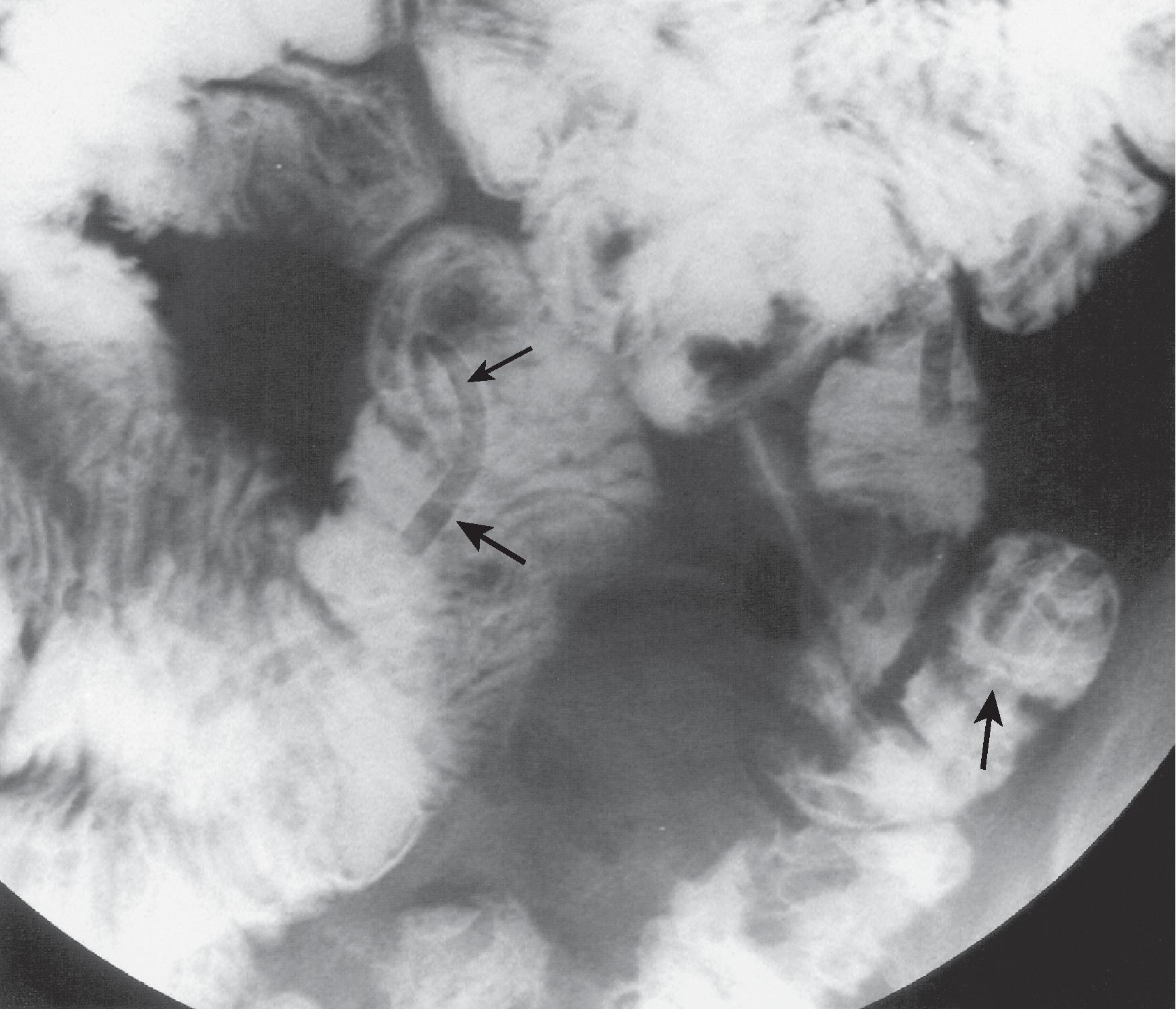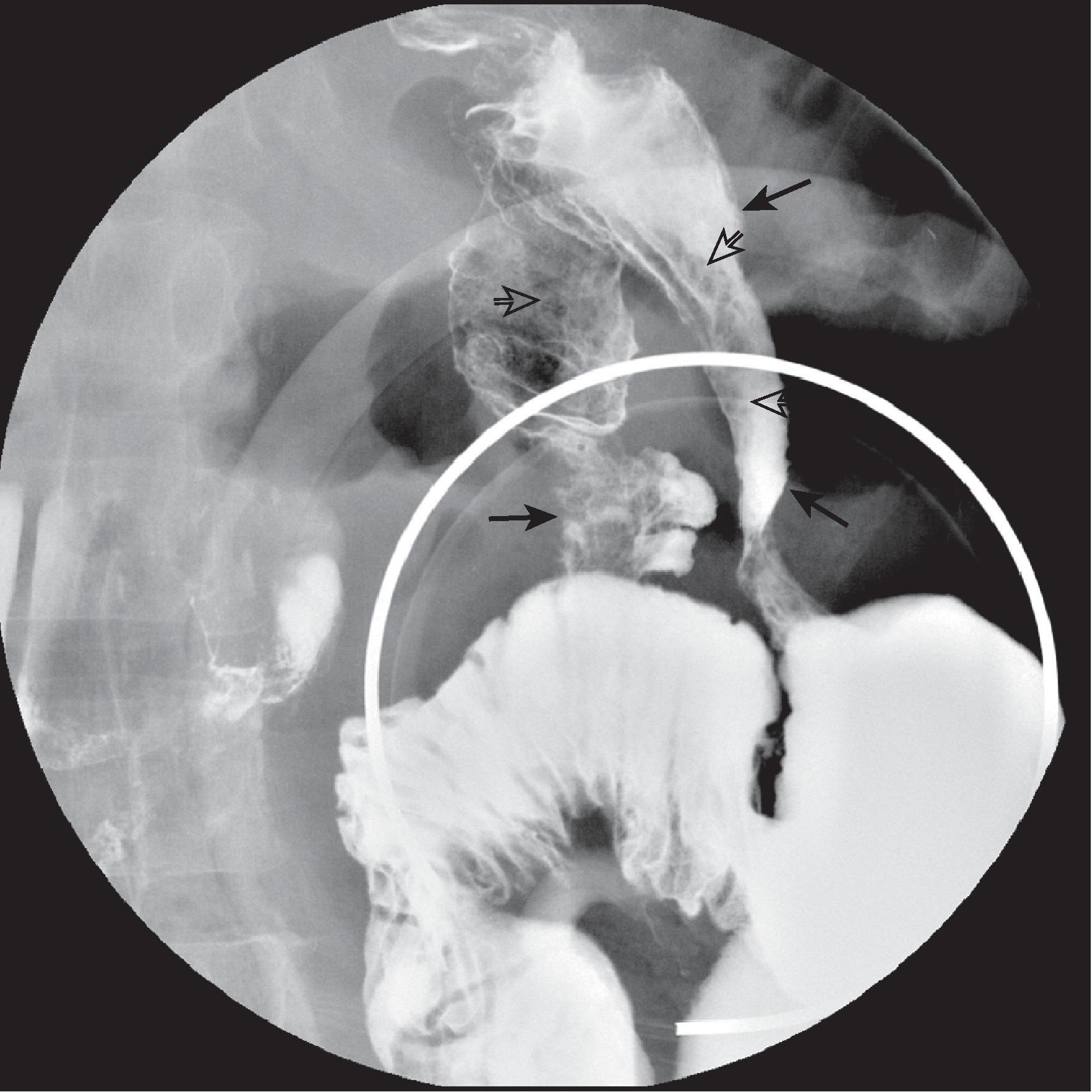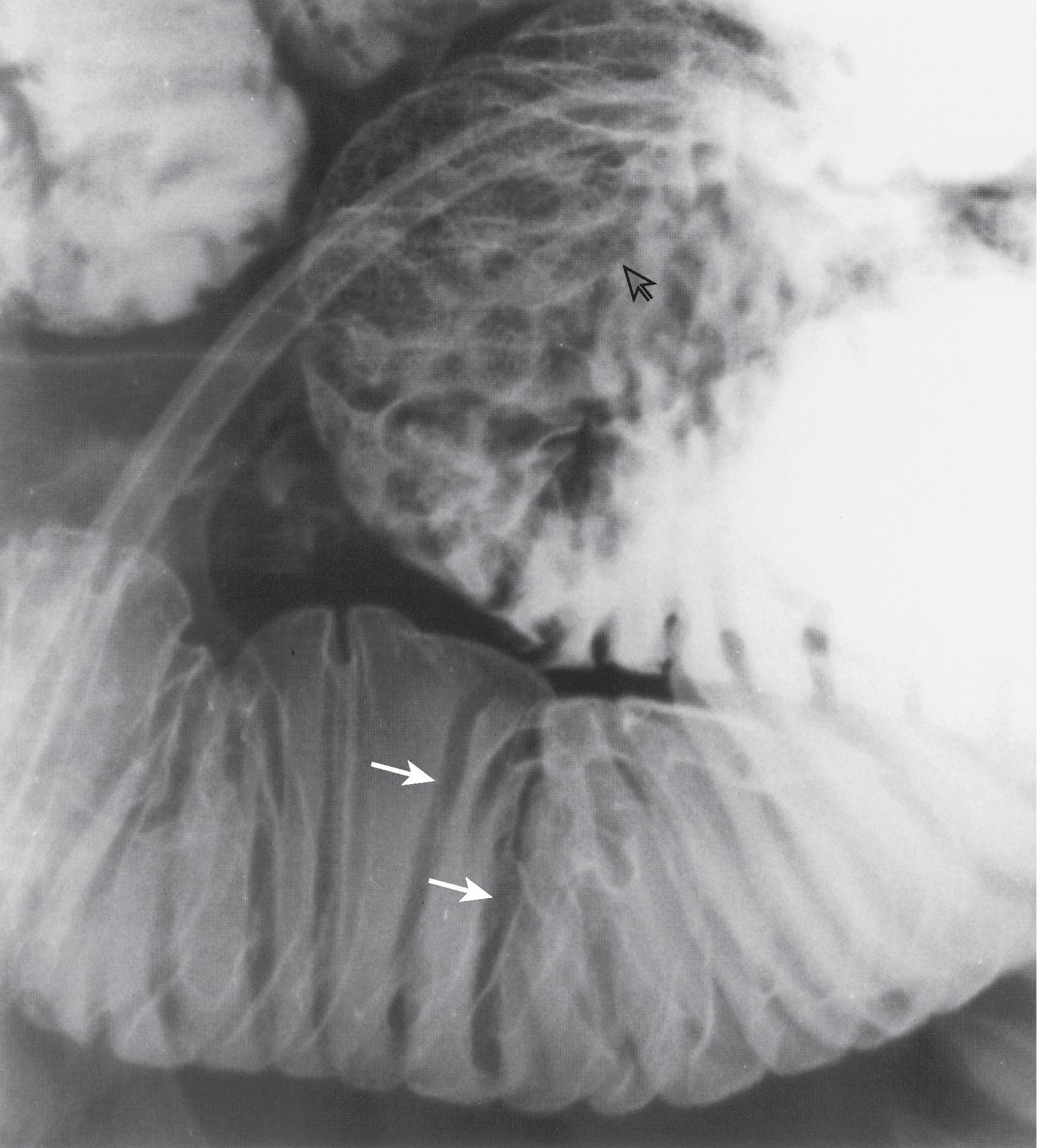Physical Address
304 North Cardinal St.
Dorchester Center, MA 02124
The radiologist usually encounters infectious disease of the small intestine during the workup of patients with acute abdominal pain or diarrhea or with chronic diarrhea, malabsorption, and weight loss. If computed tomography (CT) reveals thickened ileal folds or regional mesenteric adenopathy in patients with acute symptoms, various infectious pathogens (e.g., Yersinia ) should be considered ( Fig. 28.1 ). Stool cultures and biopsy specimens often fail to provide a definitive diagnosis. This chapter discusses various pathogens and conditions that affect the small intestine (excluding those that cause malabsorption) and describes their radiographic findings.
Worms and protozoa infect more than 25% of the world’s population. Helminths (worms) are classified as roundworms (nematodes), tapeworms (cestodes), and flukes (trematodes). Nematodes are round, unsegmented, and divided into separate sexes. Cestodes are tapelike, segmented, and hermaphrodites. Finally, trematodes are leaf-shaped, unsegmented, and are also hermaphrodites.
Ascaris lumbricoides is the most common intestinal worm(a roundworm or nematode), infecting about 25% of the world’s population, most frequently in the tropics and subtropics. Ascariasis is acquired by ingesting mature eggs from contaminated soil, food, or water. About 2 to 3 weeks after ingestion of eggs, larvae develop in the small intestine. The larvae penetrate the mucosa, enter vessels in the bowel wall to reach the portal venous system, and migrate through the liver and heart to the lungs. The larvae then penetrate alveoli, enter the tracheobronchial tree, and are swallowed. Development is completed in the small intestine, where the worms attach to the mucosal surface of the jejunum. Worms may grow up to 40 cm in length.
Symptoms include abdominal pain and malabsorption. If the worms are present in large numbers, ascariasis may cause small bowel obstruction resulting from luminal obturation or intussusception. Mature worms that migrate into the bile or pancreatic ducts may cause cholangitis or pancreatitis.
Ascaris can be identified on abdominal radiographs, barium studies, and CT. Long, smooth, convoluted tubular filling defects are seen in the intestinal lumen on barium studies ( Fig. 28.2 ) and CT. If barium enters the worm’s intestinal tract, a long, thin line of barium will be present within the tubular radiolucent filling defect caused by the worm (see Fig. 28.2 ). Small bowel folds are usually normal in size but may be enlarged. Small nodules reflect submucosal cysts surrounded by fibrotic tissue. The radiographic diagnosis can be confirmed by detection of ova in stool specimens.

Hookworms are small (8–10 mm) nematodes that infect almost 1 billion people worldwide. Ancylostoma duodenale is found in southern Europe, the Mediterranean region, and the western coast of South America. In contrast, Necator americanus causes hookworm infestation in the southern United States, the Caribbean, and South America, but its incidence has decreased markedly in the United States with improved sanitation. Both species are found in India and Southeast Asia. Near adult stage larvae and adult worms attach to the small bowel mucosa. Ova are secreted into the feces. Infection results primarily from filarial invasion of the hands or feet in people who walk barefoot.
Hookworm infestation may cause abdominal pain, diarrhea, or acute gastrointestinal (GI) bleeding, but iron-deficiency anemia is the most common clinical finding. Peripheral eosinophilia is also present in many patients.
The jejunal mucosa is edematous and hemorrhagic at sites of intestinal attachment. Hookworms have not been demonstrated on barium studies, but jejunal fold thickening and irritability may be present. Ileal strictures and regional lymphadenopathy have also been reported. A definitive diagnosis requires demonstration of ova in stool specimens or worms in jejunal aspirates or biopsy specimens.
Strongyloides stercoralis is a nematode usually found in the tropics and subtropics and in areas of poor sanitation or areas in which human waste is used as fertilizer. In the United States, strongyloidiasis is found in people living in Appalachia, military personnel returning from endemic regions, and patients who are immunocompromised because of malnutrition, steroids, AIDS, or other causes.
Filariform larvae (ranging from 0.2 to 0.5 mm in length) penetrate the skin, migrate through the venous system to the lungs, penetrate alveoli, enter the tracheobronchial tree, and are swallowed. The larvae are transformed into adult worms in the small intestine. Female worms penetrate the duodenal and jejunal mucosa, surviving in the superficial layers of the proximal small bowel. Male worms may be expelled.
Unlike other nematode diseases, strongyloidiasis is characterized by autoinfection that may be life-threatening in immunocompromised hosts. Eggs released into the intestinal lumen form rhabditiform larvae that develop into infective filariform larvae in the intestinal lumen or in the soil. These filariform larvae may then reinvade the intestinal mucosa or perianal skin. Most larvae die in intestinal lymphatics or in thesmall bowel mesentery. Strongyloidiasis causes a variety of clinical findings, including abdominal pain, diarrhea, weight loss, and malabsorption.
Mild infestation by strongyloidiasis cannot be detected on imaging studies. With chronic infection, barium studies may reveal thickened folds in the duodenum and jejunum. With severe infection, small bowel folds are effaced or obliterated, producing a “pipe stem” appearance in narrowed, tubular jejunal loops ( Fig. 28.3 ). , Strongyloidiasis is also a cause of papillary stenosis and small bowel dilation. A definitive diagnosis can be made on duodenal aspirates or biopsy specimens.

Members of the Anisakidae family are nematode parasites of marine mammals. Anisakis larvae are found in intermediate hosts such as squid and fish. Human infection is acquired by eating raw, inadequately cooked, or pickled fish. Anisakiasis is therefore most common in areas where raw fish such as sushi or sashimi are frequently eaten. Ingested larvae usually attach and invade the stomach, but small or large bowel involvement may also occur. Edema and inflammation develop at the site of attempted larval penetration. Ulceration and perforation have also been reported. When the small bowel is involved, the clinical presentation can mimic appendicitis, Crohn’s disease, or small bowel obstruction.
Anisakis larvae have been detected on double-contrast studies of the stomach and colon as thin, curved, 5-mm filling defects in the shallow barium pool. Focally thickened, irregular folds may be seen in the small bowel. Strictures and short, ulcerated lesions have also been described. In patients with focal perforation and abscess formation, a mesenteric mass or abscess may be detected on abdominal CT.
Cestodes live as adults in the GI tract of definitive hosts and as cysticerci in the tissue of intermediate hosts. Humans are the definitive hosts for Taenia saginata (beef tapeworm), Taenia solium (pork tapeworm), Hymenolepis nana (dwarf tapeworm), and Diphyllobothrium latum (fish tapeworm). Humans are intermediate hosts for Echinococcus granulosus, Echinococcus multilocularis, and T. solium. These worms attach to the intestinal mucosa by a scolex. A connecting region is followed by the strobila and a ribbon-like chain of developing segments (the proglottids). The number of proglottids varies from 3 to 4000, and the length of the cestode varies from several millimeters to several meters.
Humans are infected by eating inadequately cooked beef, pork, or fish. After infected flesh is ingested, the cysticercus breaks down, releasing a scolex that attaches to the upper jejunum. The adult worm develops, and proglottids and ova are released into the lumen. Tapeworm infection usually causes no symptoms. Because of its length (up to 4–6 m), T. saginata may cause obstructive symptoms. In contrast, D. latum may cause vitamin B 12 deficiency and macrocytic anemia.
A variety of flukes involve the liver, biliary tract, and intestines. The genus Schistosoma infects more than 150 million people worldwide. Schistosoma mansoni is endemic in Africa, the Middle East, and Latin America, Schistosoma japonicum is endemic in Asia, and Schistosoma haematobium is endemic in the Middle East and Africa . S. haematobium mainly causes genitourinary disease but is occasionally found in the appendix. Because colonic infection by schistosomiasis is more common than small bowel infection, this disease is discussed in Chapter 42.
Giardiasis is the most common parasitic disease worldwide. In the United States, giardiasis is usually found in the Rocky Mountain states. Surface water contaminated by feces from wild animals is the principal source of infection. Cysts remain viable in cold water for 1 to 3 months and can also survive the chlorine levels in many municipal water systems. Giardiasis is mainly transmitted by fecal-oral transmission from contaminated food and pets and occasionally by oral-anal contact. The risk of infection is greater in patients with immunodeficiency states and hypochlorhydria.
After cyst ingestion, trophozoites emerge in the duodenum and proximal jejunum. The trophozoites remain in the intestinal lumen or penetrate the mucus gel layer of the proximal intestine to attach to the glycocalyx in enterocytes. Trophozoites do not invade the epithelium. Mature cysts are excreted in the stool.
The infection varies from an asymptomatic carrier state to self-limited diarrhea or chronic, watery diarrhea. The small intestine frequently appears normal on small bowel follow-throughs. In about 50% of patients, there is increased intraluminal fluid and rapid small bowel transit. Thickened duodenal and jejunal folds and irritability have also been described ( Fig. 28.4 ). Because barium studies are abnormal in fewer than 50% of infected patients and radiographic findings are nonspecific, a definitive diagnosis requires a positive fluorescent antibody test or detection of cysts or trophozoites on stool examinations or duodenal aspirates or biopsy specimens.

Chagas’ disease is caused by the protozoan Trypanosoma cruzi, spread by the bite of the reduviid bug. Chagas’ disease is endemic in central Brazil, northern Argentina, and Venezuela but has also been reported in southern areas of the United States. It is estimated that 350,000 people in the United States are seropositive for this infection. T. cruzi produces a neurotoxin that attacks autonomic ganglion cells throughout the body, including those in the heart, GI tract, urinary tract, and respiratory tract. The esophagus, duodenum, and colon are the GI organs most commonly affected, resulting in secondary achalasia, megaduodenum, and megacolon. Involvement of the small intestine leads to small bowel dilation and delayed transit.
Traveler’s diarrhea and foodborne diseases are common problems related to tainted water supplies and improperly prepared or stored food. Bacteria are the organisms usually responsible for traveler’s diarrhea, so the prophylactic use of antibiotics decreases the incidence of traveler’s diarrhea. This condition is most commonly caused by enterotoxigenic Escherichia coli and, less frequently, by enteropathogenic and enteroadherent E. coli . Shigella and Campylobacter jejuni are other common pathogens, but these bacteria typically involve the colon. Most patients who develop acute watery diarrhea during or shortly after a period of travel are thought to have traveler’s diarrhea, so affected individuals rarely undergo imaging studies.
Become a Clinical Tree membership for Full access and enjoy Unlimited articles
If you are a member. Log in here